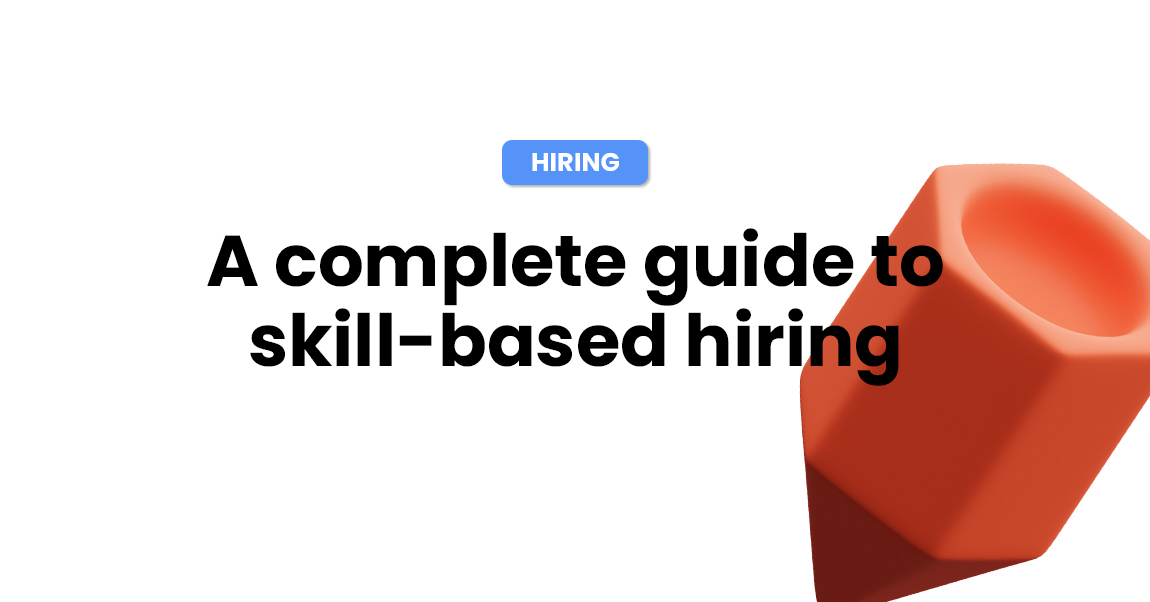Although hiring is unstoppably evolving, some things will always remain the same. For example, all companies aim to attract and retain skilled and diverse talent. So, what’s actually changing are the ways to reach, entice, and hire those professionals. Today, there’s a huge need for skill-based hiring.
So, how does it work, and what should you learn? First of all, you must understand what a skills-based hiring practice is and what isn’t. Then, you should focus on discovering some substantial benefits that accompany it. And lastly, to get the best results, you should take certain ingredients from this approach and charge up your internal processes with them.
Now, get ready because we’ll offer you a step-by-step guide & cover a few simple ways to understand this practice and implement it correctly.
A basic term to grasp: What is skill-based hiring?
This entire concept is very simple and fail-proof. In this case, it’s all about the targets you set. Hiring based on particular sets of skills implies setting specific skill or competency requirements – and looking for the fitting candidates accordingly! It usually encompasses a few key soft skills, and in our niche, it’s mostly about the hard skills or tech knowledge. Also, formal background and education don’t play a significant role in this arrangement. And finally – performance and potential are what actually counts.
In addition, DeBruce-Foundation has offered a list of basic skills an employee should possess (and be encouraged to amplify over time):
- Communication and interpersonal skills,
- Critical thinking,
- Proactivity,
- Collaboration + self-accountability.
So, according to this study, all employees should have these traits and know-hows. Regardless of the role you are recruiting for, these competencies are usually pivotal.
Know the difference between skills-based hiring & degree-based hiring
By now, the difference between these approaches should be evident. Still, getting a bit more methodical about this topic can help. Wanna know why? Even the simplest tactics can get inconsistent when you put things in motion. A good idea on paper can somehow be reshaped once it’s set to action.
So, here’s the ridiculously catchy phrase to memorize & hire by: upskilling and reskilling come before reference checking and “pedigree”.
And that is why skills-based hiring reaches far more spheres than tech recruitment. Just look at the way eCommerce is booming. Also, the food industry has undergone substantial changes. And so did nearly every niche. So, while many roles still do require education degrees, formal certifications, or considerable industry experience, the shift toward minding the skills more is indisputable and on the way to help businesses (and employees) thrive.
The best skill-based hiring practices
Each hiring tactic stands in need of an occasional retouche – much like recruitment skills and all means and techniques that bring results and expand companies. If you shoot for the stars, it’s necessary to remain up to date and prone to try out new approaches and practices. Especially the ones that were so far proven as good ones.
So, here’s a brief guide on how to adopt skills-based hiring practices:
- Start from the top: know who you need on your team,
- Focus on the key skills: list your “must-have” and “nice to have” abilities accordingly,
- Write (or rewrite) your job descriptions: keep them brief, precise, informative, and engaging.
If you want to improve your recruitment process, you might not need to take it to ground zero. It’s often a little brushing up that can do the trick. However, it’s essential to start with those job openings that have the highest time-to-hire and turnover rates. Direct your attention to them and see what needs to be fixed.
Keep it simple: Identify a need & take small steps
So we begin. Let’s go through the initial steps, starting with identifying a hiring need. It comes down to learning about the precise skillset you should have on your team. To understand it, you should have an internal assessment and see which masteries are lacking at the moment. Then, be objective when measuring their significance, and know whether you’ll certainly need them in the long run. Finally, start to overcome the gaps by writing precise job descriptions, distributing them, and sourcing fitting candidates actively. If there’s a hiring need you must fulfill in a snap, it’s best to get in touch with a reliable recruitment agency. Their dedication and industry knowledge will likely become your best allies and hold the key to your success.
Keep it efficient: Learn why skills-based hiring begins with a job description
Now, here’s another nitty-gritty step to take – learning how to write a job description correctly. Once again, it begins by knowing your exact aims. Surely, it must contain the key responsibilities and competencies required from a candidate. But that’s not all. So, how do you write a skills-based job description? These are the basic elements you must take into account:
- A specific job title that’s defined by a key phrase,
- The brief intro that offers job seekers an insight into your company’s value proposition,
- A list of principal duties and main responsibilities a new hire will be focusing on a daily basis,
- Requirements and preferences – carefully put to inform the audience about what they must bring to the table and what you’d like to obtain on board, but it’s not actually vital for the role.
Aside from these unavoidable ingredients, you should also add a paragraph about the employee benefits you offer, and development plans your new hires will count on. And if you want to win big, it’s best to bring up a salary range. Full transparency is crucial in many ways. For once, it will ease the salary negotiation. And, by that, you’ll save a lot of time and energy – which will positively influence the recruitment process, its outcomes, and candidates’ perception of your brand. To name a perk or two.
The major benefits of skill-based hiring
Regardless of whether you have an in-house team of sourcers or choose to outsource recruitment processes, skill-based hiring is a practice you should undoubtedly look into. It can help you out in multiple ways. You’ll reach excellent results throughout each stage: from the initial touchpoints and making strong first impressions that turn candidates into brand ambassadors to ultimate goals like improving employee retention, engagement, and satisfaction. So, get ready to dive in deep and learn the advantages of this popular approach.
Meet more top talents
Picture this: a super skilled professional takes a sneak peek at your job posting. They’re about to hit the apply button. But then, they see that one of the “must-haves” includes a college degree. And since they don’t have one, they skip the opportunity and move on to meet another employer. It’s your loss. This candidate most likely had what it takes to enhance your internal skillset and skyrocket your profits in the long run. But they didn’t match the requirements list. Be extra careful when it comes to these angles and ensure that the best active and passive talents know about the dexterity you’re truly after.
Save more time & money
One in five companies has a hiring process that takes more than two months. And that’s a huge obstacle and a tested way to waste everyone’s time + lose a potential hire and diminish the efforts you’ve invested in your brand.
But once your talent pool is extended – thanks to skill-based hiring, it’s far more likely that you will find and hire the most suitable candidate much sooner. That way, you will enjoy the true advantages of an efficient recruitment process, which include enhanced metrics, cut costs, and a better experience all around.
Pro tip to save even more time + money: Pair up with a reputable recruitment agency. The odds are that their efforts and a knack for recruiting top talent within a specific niche will drive the most astonishing results!
Boost employee retention
Employee experience is a sum of all notions, ideas, and feelings a team member gathers throughout the time they work for a specific company. And, you’ve guessed it right – it has a lot to do with the retention rates! So, where to start and what to consider?
In this case, as well, it’s paramount that you build a firm bond with them from the initial point of contact. In other words – back to square one, from identifying an actual hiring need, writing a captivating JD, and refining your recruitment strategies. Why so? Well, each new hire used to be a candidate, right? And they’ve gone through the entire interviewing process – and more! So, skills-based hiring done right has a tremendous impact on the way they have perceived your firm from day one. Moreover, it will bring them new colleagues with relevant skillsets and knowledge they’ll share and combine to bring the optimal outcomes.
Finally, mind the onboarding process, and stay consistent with your goals. Keep on offering learning and growth opportunities through the whole employee lifecycle.
Promote diversity & build a remarkable company culture
Pew Research Center discovered a few frightening statistics. According to the research conducted in 2017, 42% of women have been discriminated against in the workplace. Now, these no good figures need to be changed. Diversity and inclusion matter a lot in more ways than one. And a skill-based hiring practice can help. By focusing on the abilities more than any other aspect can boost heterogeneity on the team. That way, each member will get the chance to learn more from a colleague with an entirely different background and fresh insights and mindset.
Bonus tip: support & reward your employees
How does upskilling your current talent sound? If you have some doubts, take it from Amazon – they’ve invested over $700 million to educate and train their employees. And this is also more than an HR trend. It’s a tested way to secure a bright future for each employee and the company as a whole.
But, what cafeteria plan is in the world of employee benefits, your career growth plan should be in your very own environment. Make it count by making it personalized, optimized, and destined to succeed! Mind each employee’s unique necessities and objectives, and plan their upskilling meticulously.
Skills-based hiring is the ultimate trend & an effective way to strengthen your team’s competencies
Yes, we just called it a trend. In a manner of lacking a more suitable phrase, we’ll label it that way. But we’ll all know it’s way more than that, right? Hiring to obtain a specific set of skills is an awesome way to boost your recruitment tactics, shorten the processes, save resources, and speak out to candidates in a more effective way. Also, it does you good internally – and long-term! What more can you ask for?
And if you need to rely on a professional recruitment agency that covers each and every single aspect that makes this approach powerful and efficient – here’s your magic link to success.




